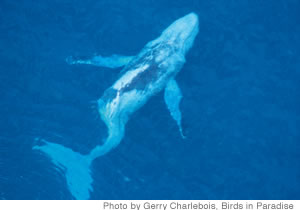Our Huge But Fragile Humpbacks

The injured whale off Port Allen
Humpback whale sightings are becoming a daily occurrence across our island state as the large mammals make their way through Hawaiian waters. Canoe paddlers and others who venture out into the open ocean are often blessed to see these massive creatures in their environment. And as I’ve shared in this column, some of our encounters have come closer than we would have liked.
It was just over a year ago on Feb. 11, 2010, when a 30-foot whale surfaced on fellow Kailua Canoe Club member Keola Lindsey. Lindsey was riding a wave on his one-man canoe about three miles out to sea. The unexpected collision destroyed his canoe and left an impact on all of us for weeks.
The experience of seeing whales never gets old. There’s always a rush when you witness one surface, and it usually happens when you least expect it. My brother-in-law Kelley and I recently felt that rush during a training run out to Diamond Head buoy. It was a calm, flat day off Oahu’s South Shore. No surf, no wind and no way we were going to call it a day, even though we were already late.
As we approached the buoy, it happened. A huge whale breached about a quarter-mile away. We froze as the massive mammal hit the water. Splash! “Did you see that?”
I screamed. Of course he did. Seconds later, the whale exploded out of the water again. For just a moment, I held my breath; then exhaled as it disappeared into the water.
Things come in threes, right? We waited, but nothing. Thirty seconds later, I yelled, “We’re out of here! This thing could be under us right now!” It was a great way to end the day.
Two weeks later, I would experience another whale encounter. This one was as memorable but not pleasant. It came in the form of photographs sent from Gerry Charlebois of Kaua’i. Charlebois operates Birds in Paradise Flight School, a premier powered hang gliding company that offers flights over the Garden Isle. The veteran instructor shot chilling images of a sick humpback whale off Kaua’i.
“I shot the photos while coming in to land at Port Allen Airport,” recalls Charlebois. “The whale was in shallow waters off of the airport about 50 yards. The color was completely unnatural and the broken back was horrible to see.”
Charlebois says he immediately notified NOAA, and Ed Lyman of the Hawaiian Islands Humpback Whale National Marine Sanctuary came out to survey the situation.
“He determined nothing could be done for the creature,” says Charlebois of the whale estimated to be about 50 feet long. “My pilots continued to keep an eye on it from the sky, but our last sighting was in the waters off of the old sugar mill on the way to Waimea later that day. We haven’t seen signs of it since.”
Lyman says the whale’s white color and thin appearance were clear signs that it was losing its skin and was seriously ill. He also added that the whale’s spine was damaged. Rescuers tried to get close to the animal, but large waves and the whale’s movement kept them away.
The grim details and graphic photos are reminders of how fragile these massive mammals really are. When they are healthy and moving majestically in the open ocean, it’s as if nothing can stand in their way. But when we see them emaciated and struggling to survive, we realize they are not immune to sickness and harm.
The sad reality is sometimes we are to blame for that harm. Whether it’s an accident or reckless behavior, we must always remember we are visitors in their world. Magnificent as they are, they are vulnerable. If you spot an injured or entangled whale, dolphin or sea turtle, call NOAA’s hot-line at 888-256-9840. rkmizutani@gmail.com
You must be logged in to post a comment.




There are no comments
Add yours